Attention all pasta-loving hearts and stomachs (!!!). Prepare yourself.
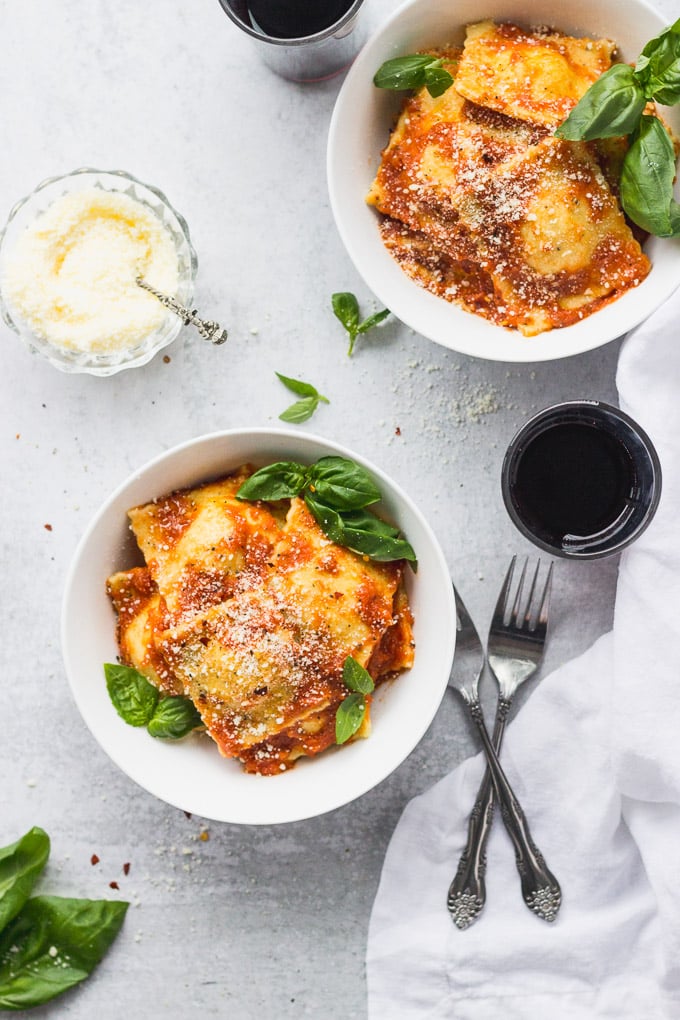
Before you know it you’re going to be diving into a big bowl of homemade ravioli and eating your heart out. It’s all excitement here, even if this is your first time exploring the world of fresh pasta from scratch.
I’m so happy to report that making ravioli in your own kitchen is easier than you might think. We’re going to walk you through each step of the process to make sure you are successful in making the best darn pasta you’ve ever had.
This is quickly going to become your favorite, fun, vegetarian dinner-turned-family activity!
Homemade Pasta Dough
Before you dive into making homemade ravioli, I would suggest you first read up on how to make homemade pasta dough.
This homemade pasta recipe is the base for this ravioli recipe and is my go-to fresh pasta recipe. It is important that you have all the backend knowledge for making fresh pasta dough before starting (hint: it includes slightly tacky, but not sticky, pasta dough!).
The good news is that once you’ve gotten homemade pasta down, there are plenty of recipes to practice (and enjoy!) homemade pasta outside of ravioli.
Practice by rolling out homemade fettuccini noodles for Shrimp Scampi or Fettuccine Alfredo, or layering fresh pasta in Vegetarian Ricotta Lasanga. That’s my kind of practice!
Then, whether it’s your first time or your bajillionth time making homemade pasta, you can prepare to be blown away by how amazing homemade pasta is in ravioli form.
So, what do you say? Pour yourself a glass of wine, queue up your kitchen dance party playlist, and let’s get to making the best from-scratch cheese ravioli you’ll ever have!
Do I have to Make My Own Pasta Dough?
I highly recommend making your own homemade pasta dough, however, you can often find fresh pasta sheets, rolled specifically for ravioli, in your grocery store.
Depending on your location, they may be harder to find at general grocery stores. Whole Foods often has a really good fresh pasta section. Look in the refrigerated or specialty part of your grocery store. There are also gluten-free options for fresh pasta dough, like Taste Republic and Cappello’s.
Mix the Dough
When it comes down to it, pasta dough is pasta dough, and you get to choose your own adventure (errr, pasta shape) with it!
In this case, we’re turning it into ravioli! My pasta dough recipe is on the heartier side, which makes it perfect for ravioli!
Start with a blend of semolina and all-purpose flour. This combination results in a firm, yet melt-in-your-mouth textured pasta. Oh, and I like to add some fresh ground black pepper to the dough for a little bite and texture, too. Of course, if you’re not so into that, you can easily leave it out.
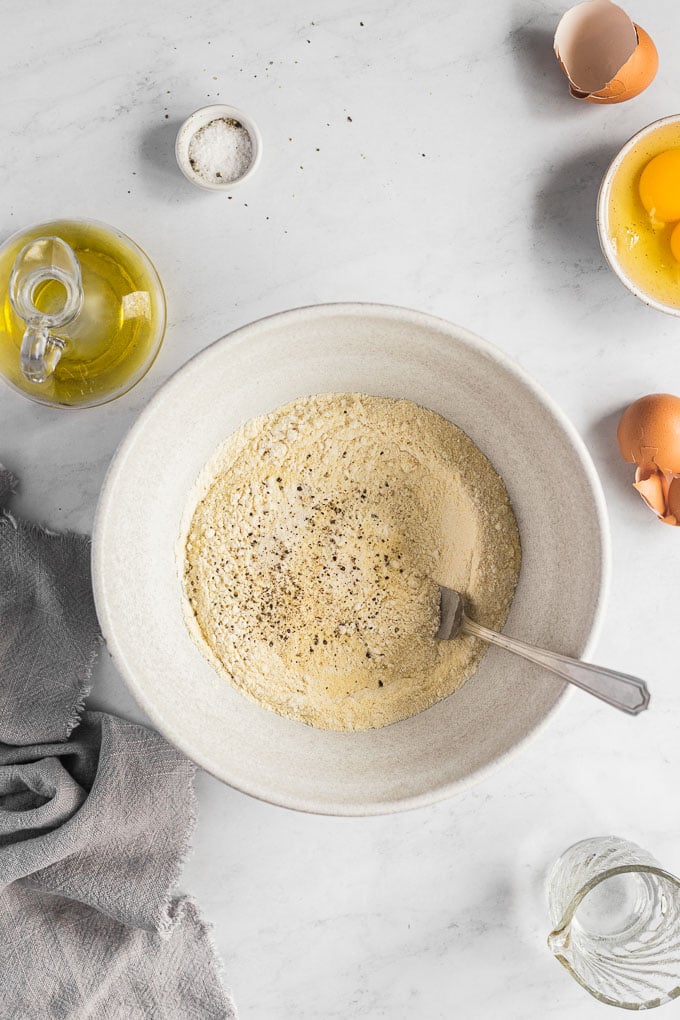
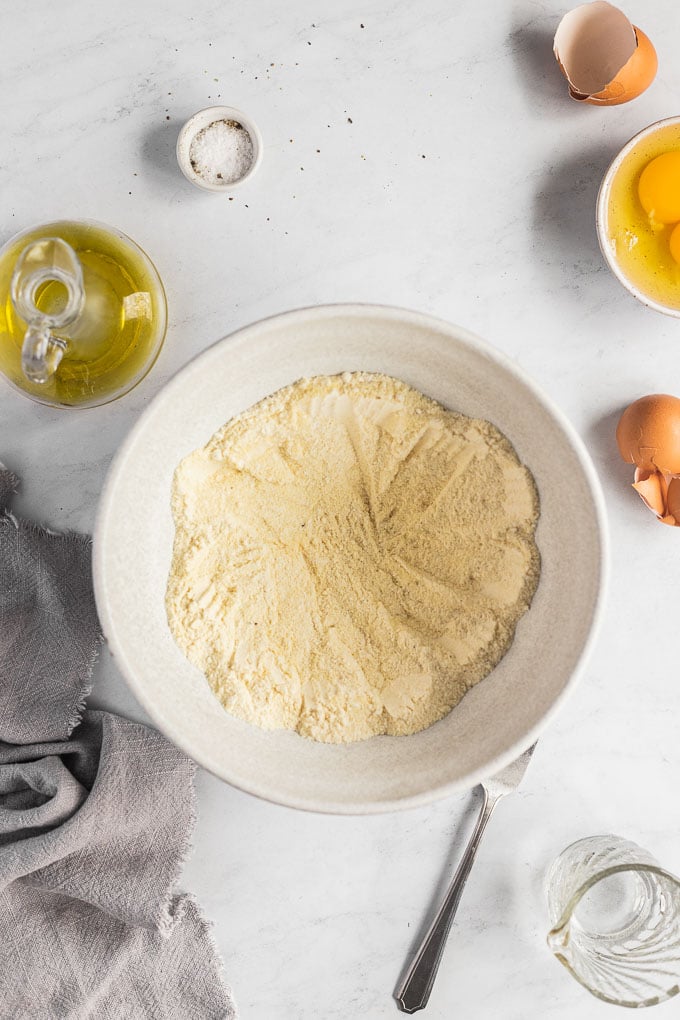
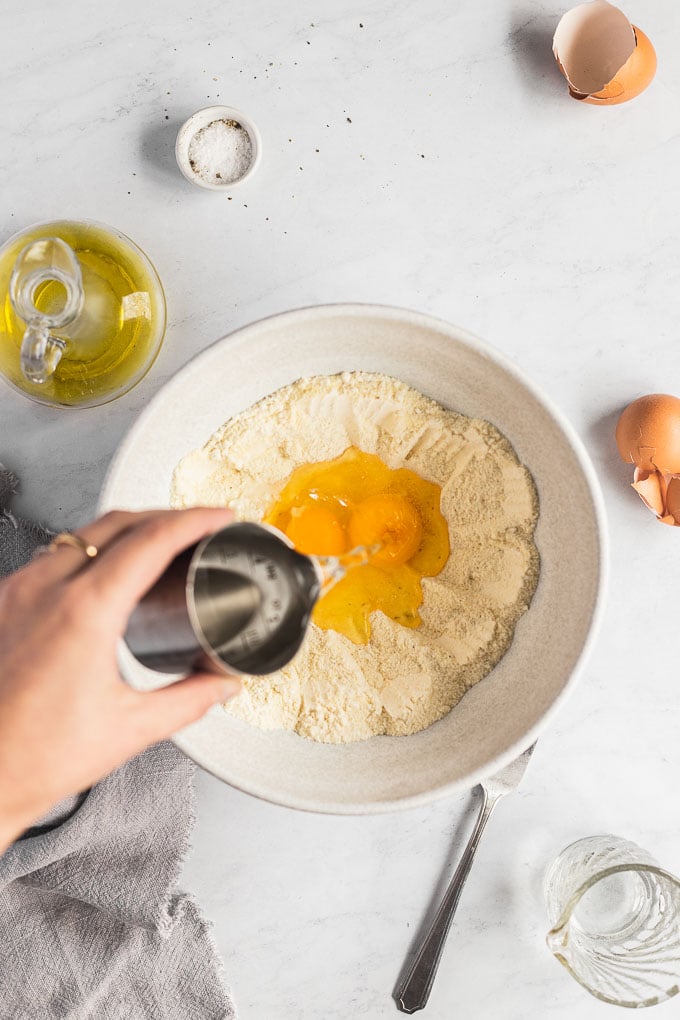
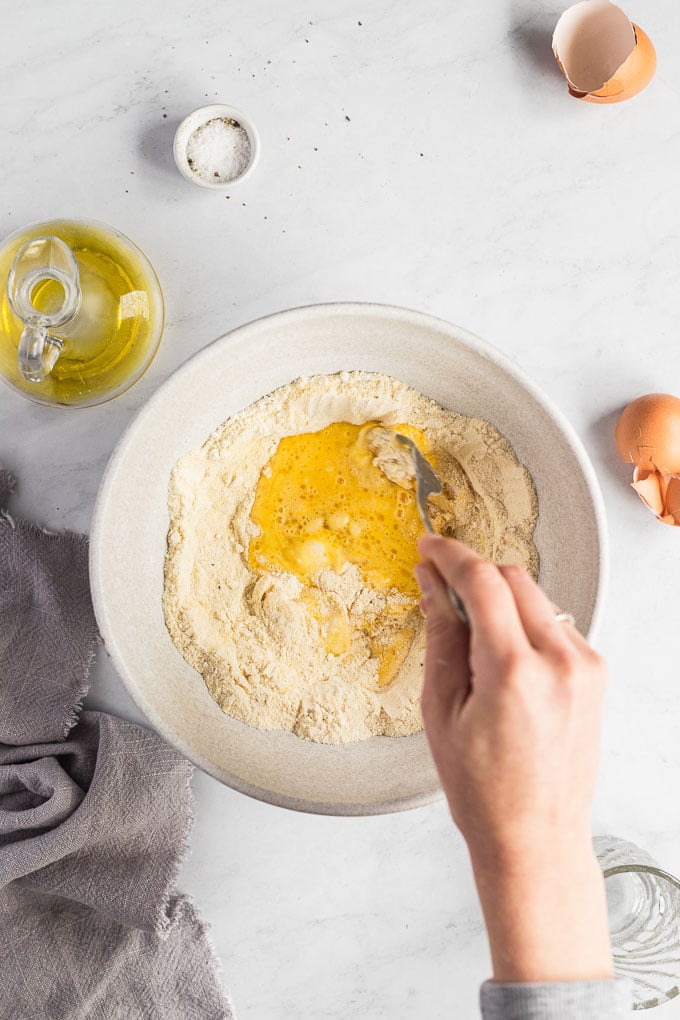
Next, whisk in the eggs, olive oil, and water.
It works best to make a well in the center of the dry ingredients, then use a fork to whisk the egg and liquids into the dry ingredients, working your way around the inside as it all comes together. Using both the eggs and oil creates a dough that is flexible enough to withstand making ravioli.
Once a shaggy dough has formed, begin to knead it together.
Using your hands, knead the dough for 3-4 minutes until it is smooth and tacky, but does not aggressively stick to your hands. If it is sticking too much, you can add a little more flour as needed, but be careful to not add too much. This is the “art” of pasta making, and you’ll get a better feel for it the more pasta you make.
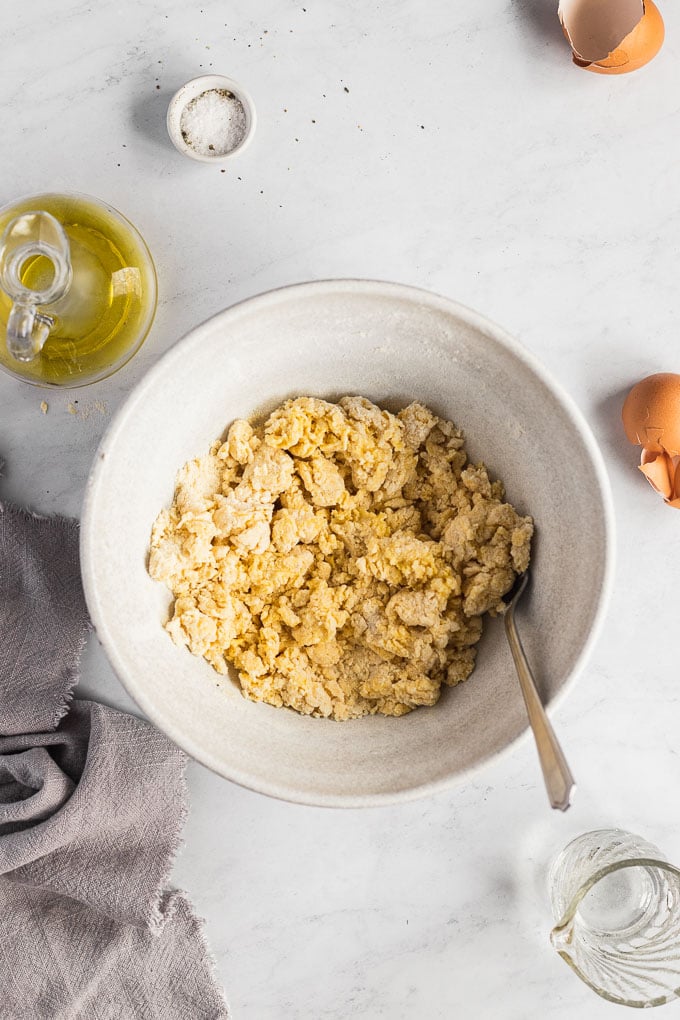
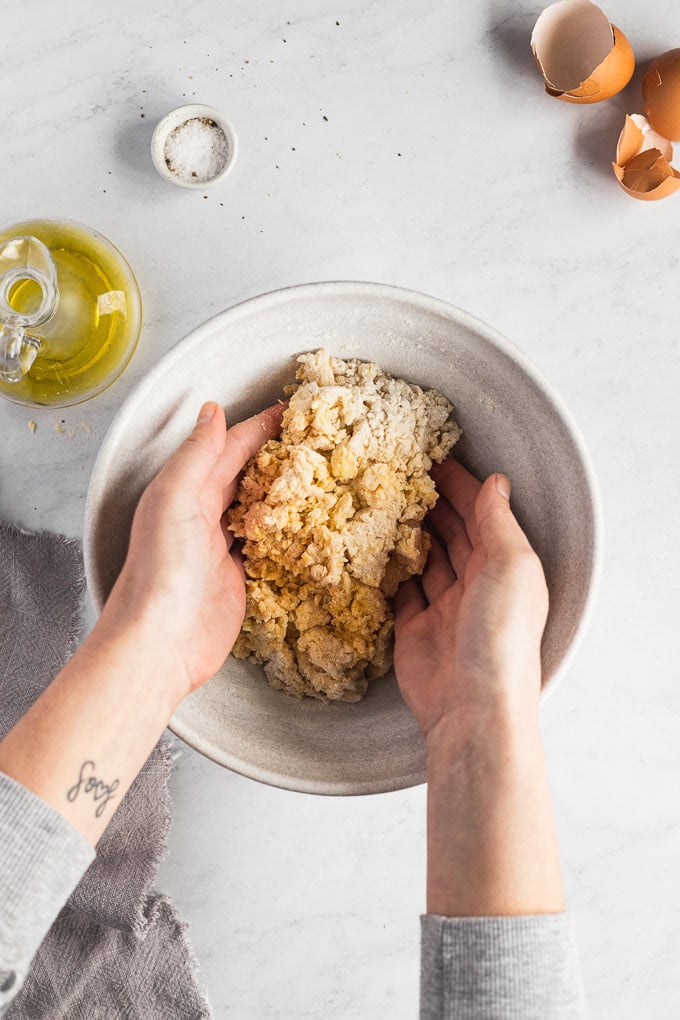
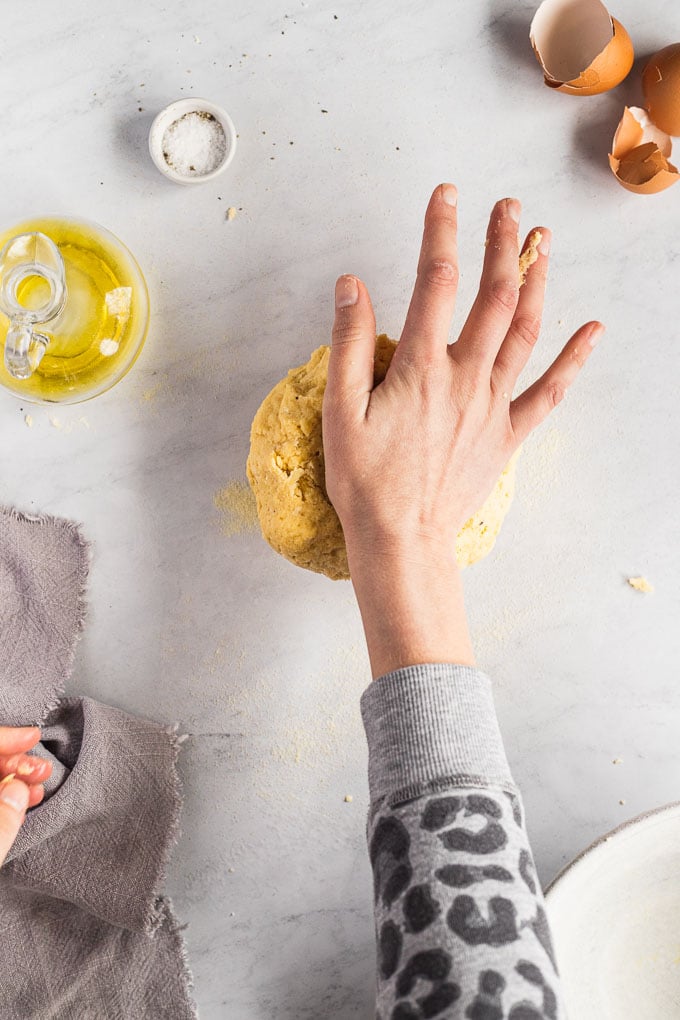
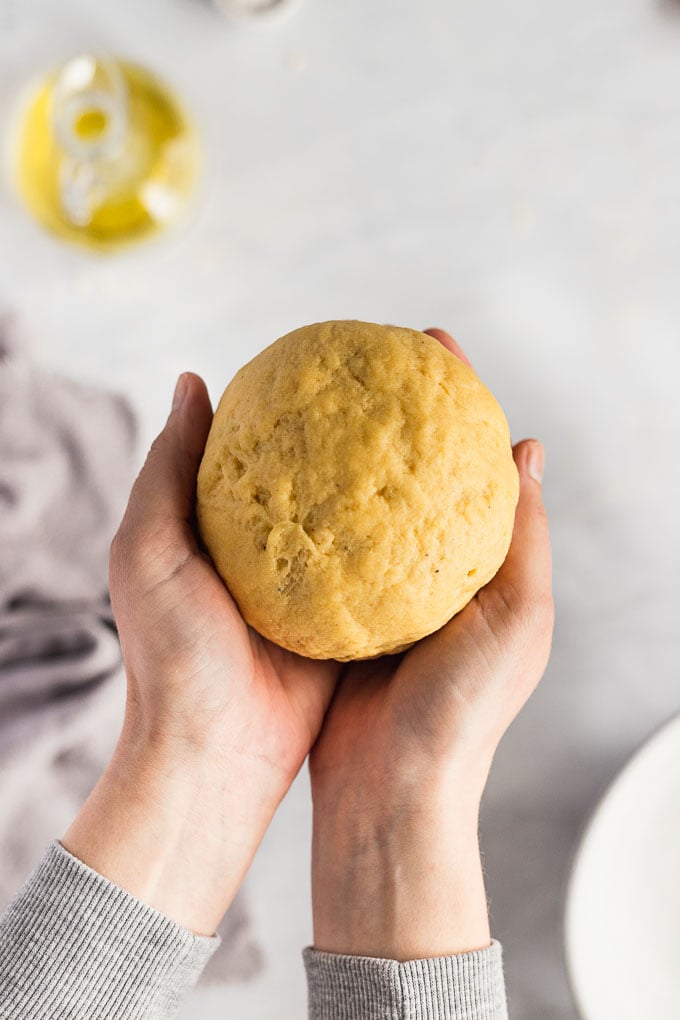
Once the pasta has been kneaded and the desired texture is reached, let the dough rest for at least 30 minutes to allow it to hydrate and the gluten to relax. You can make the dough a day ahead and store it in the fridge or make it earlier in the day, too, and let it rest until you’re ready to make the ravioli.
Once the dough has rested, you’re ready to start the ravioli process! More on forming the ravioli pockets in a minute, first we’re going to make the filling. It’s a great thing to do while the pasta rests.
Ingredients for the Cheese Filling
Ah, yes, the cheesy, cheesy, creamy ravioli filling. It’s going to steal your heart.
This cheese ravioli recipe is simple, which is what makes it so lovely. We’re not bringing out the fanfare here, we’re using basic ingredients and turning them into something magical.
This magical cheese filling has a burst of brightness and a hint of warm spice. It leaves you coming back for more, and more, and more…
Here are the simple ingredients:
- Ricotta Cheese
- Parmigiano Reggiano (or parmesan cheese)* – to keep vegetarian, read the labels – Whole Foods 365 and BelGioioso both have specifically vegetarian parmesan cheeses
- Lemon Zest
- Nutmeg
- Fresh Basil
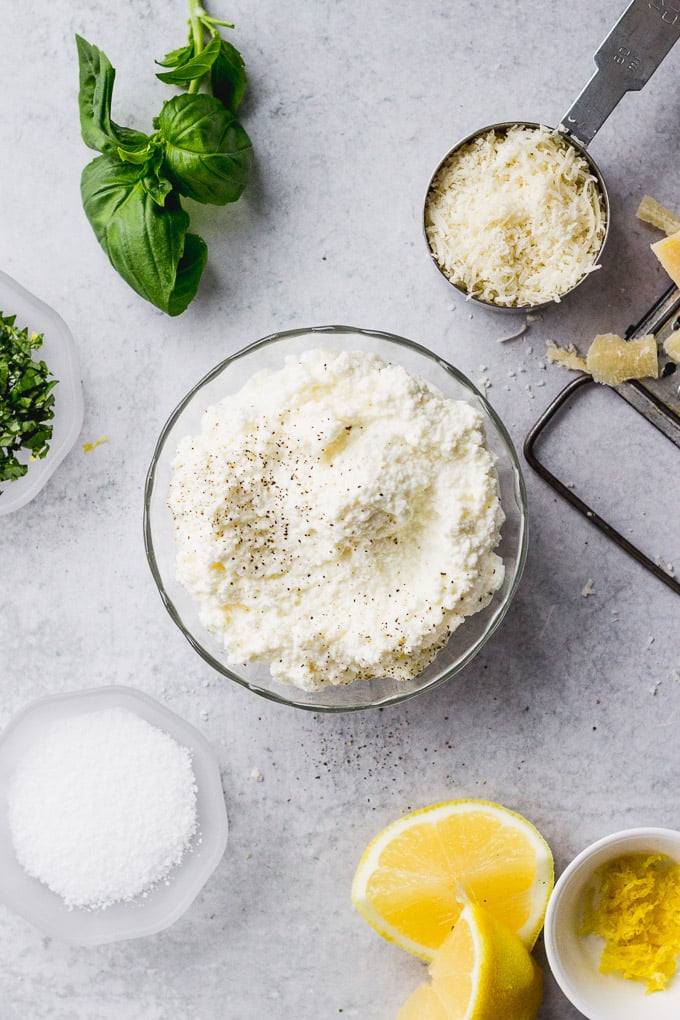
How the Flavors Work Together in this Filling
The ricotta and parmesan cheeses are the base of this cheese ravioli recipe, they melt together and create a light, creamy, airy ravioli filling.
Paired with bright lemon zest, it adds freshness to the ravioli. Really, the freshness it brings with just a little in there is unmatched. It takes it from meh cheese ravioli to paz-wow-clam-a-lam cheese ravioli.
The pinch of nutmeg adds a little bit of je ne sais quoi and depth to the filling. You won’t necessarily notice that it’s there, but it gives the filling another dimension without being overpowering. It’s undefinable but adds a WOW factor.
Fresh basil really brings in more bright freshness to the ravioli pockets, too.
That being said… winter is my favorite time to make homemade cheese ravioli. HELLO, COMFORT! This means fresh basil is not always the most cost-effective ingredient. If you need to, you can substitute dried basil, just halve the amount.
This simple base is 100% customizable to your tastes/likes/needs! The beauty of an egg and meat-free filling is that you get to taste it along the way so it’s just how you like it. WINNING.
That being said, feel free to take this recipe and adjust it to your preferences.
For a firmer filling, as opposed to the softer, melt-in-your-mouth filling that the ricotta offers, add shredded fresh mozzarella to the filling for a little three-cheese trifecta.
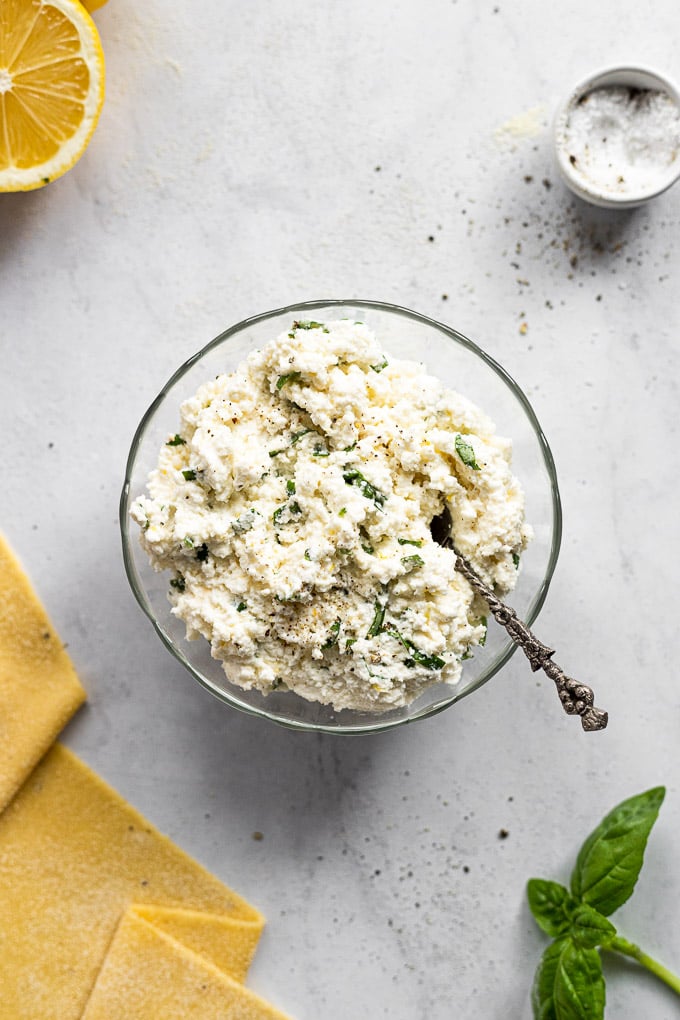
How to Make Cheese Ravioli
Be sure to see the video for more visuals, and as always, be sure to check the recipe card below. For more details, read how to make ravioli without a machine.
I’m going to share with you my favorite, and in my opinion, the simplest, way to make the ravioli pockets.
You can purchase a more elaborate ravioli maker, but it’s totally not necessary. I’ve been making ravioli equipment-free with this fold-over technique for years and years, and it never fails me.
The pockets come out looking more rustic and clearly homemade, too, which I love. Let’s get to it!
First, roll out the fresh pasta dough
Step one: roll out a section (I use about 1/4 of the dough) of the fresh pasta dough into one long thin sheet – as evenly rectangular as possible.
Use your pasta machine for the best results, but a rolling pin will work too if you want to make this recipe completely by hand and equipment-free.
Start to roll out the dough by forming the section into a small rectangle using your hands, thin enough that you can begin to thread it through the pasta roller.
Start with your pasta roller on the largest (widest) setting. This doesn’t have to be perfect, you just want to start encouraging the pasta to roll into a rectangular shape.
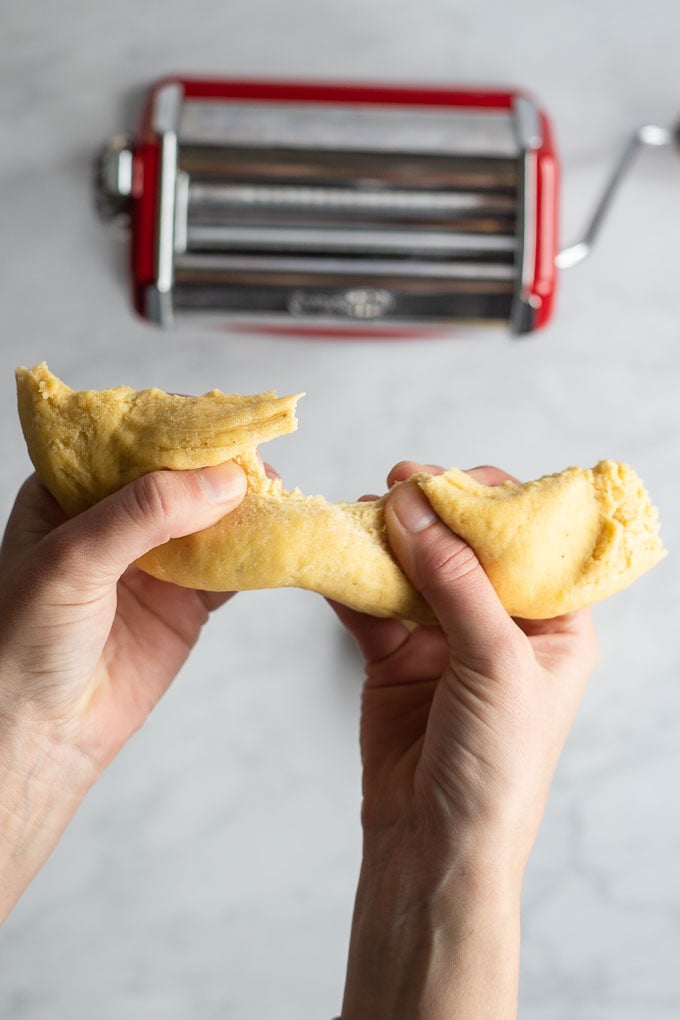
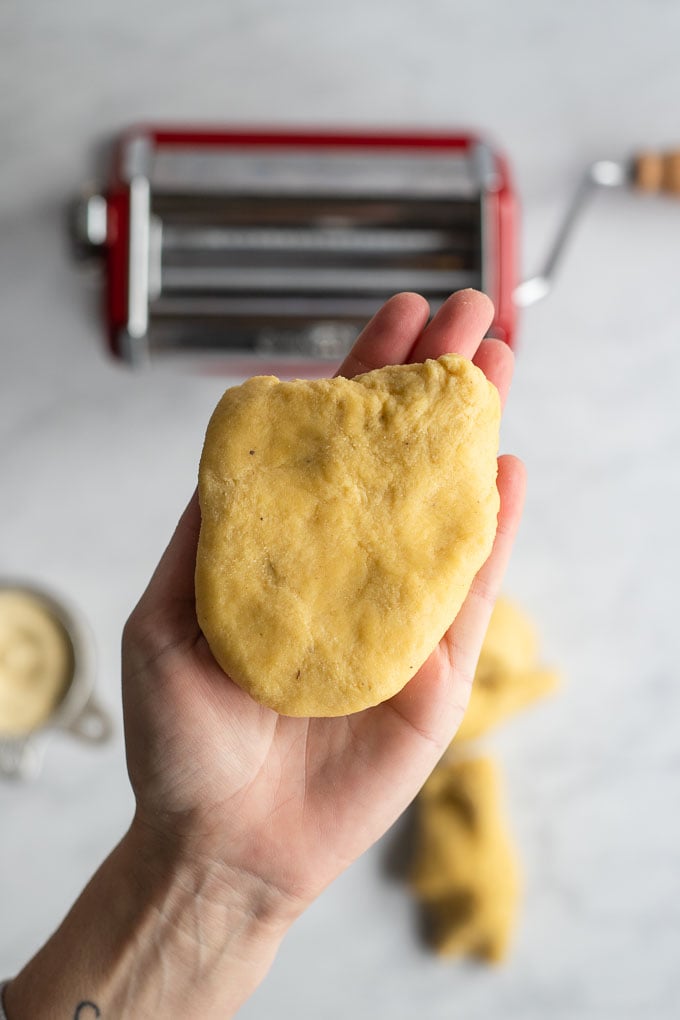
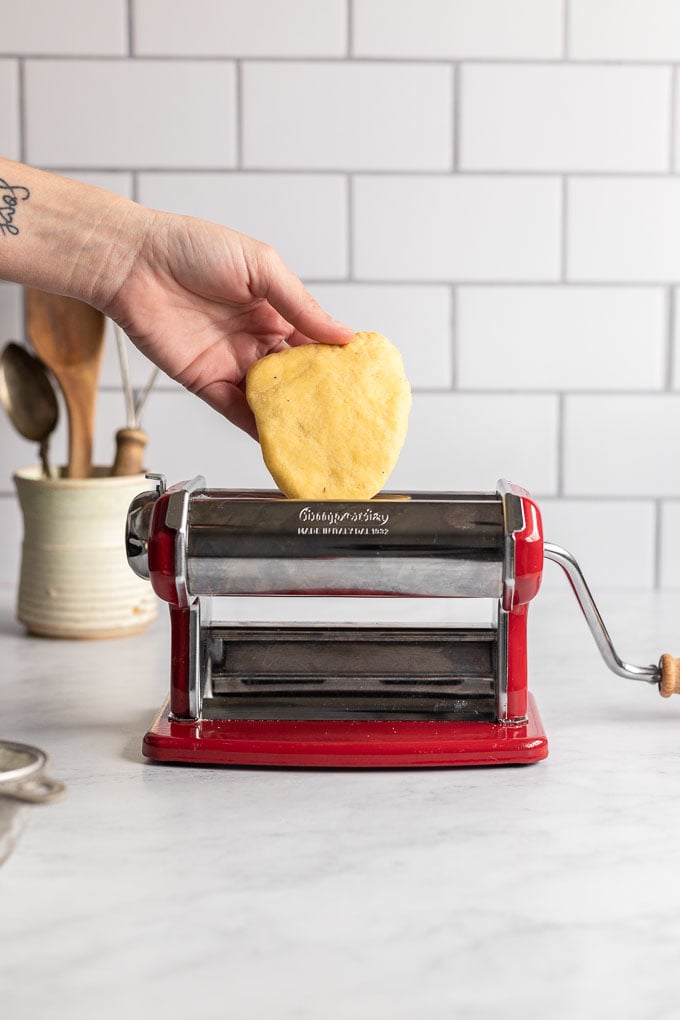
Roll out the pasta dough on that widest setting, then fold it into a rectangular shape again, as needed, and roll again.
Each time you roll out the rectangle, it will expand depending on how it was placed into the roller. Making the section into a uniform rectangle (as much as possible) will help you later on.
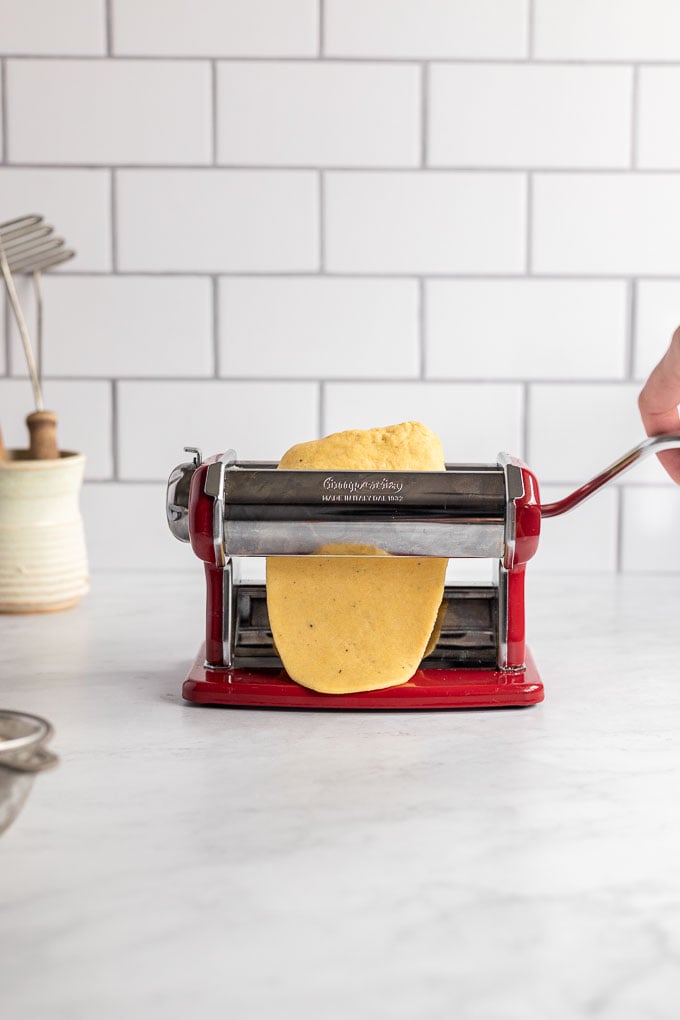
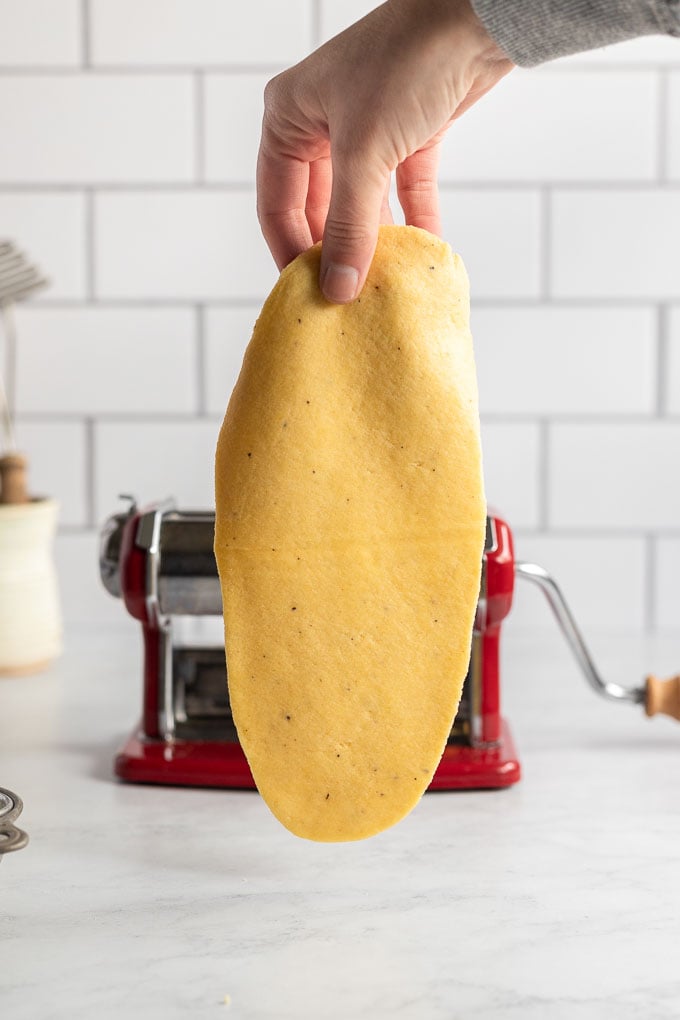
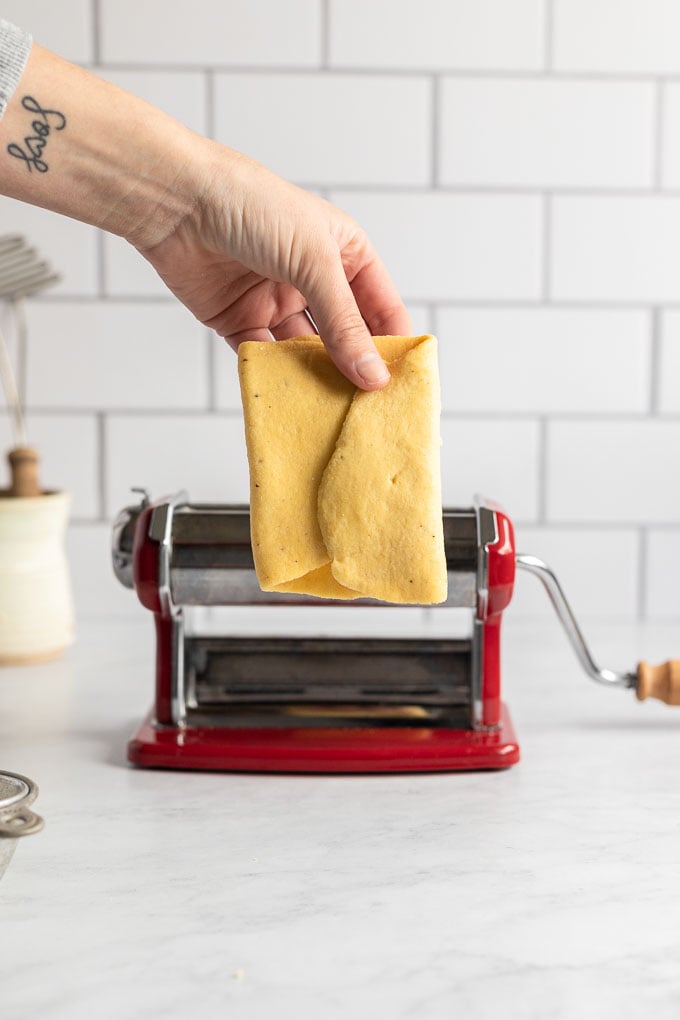
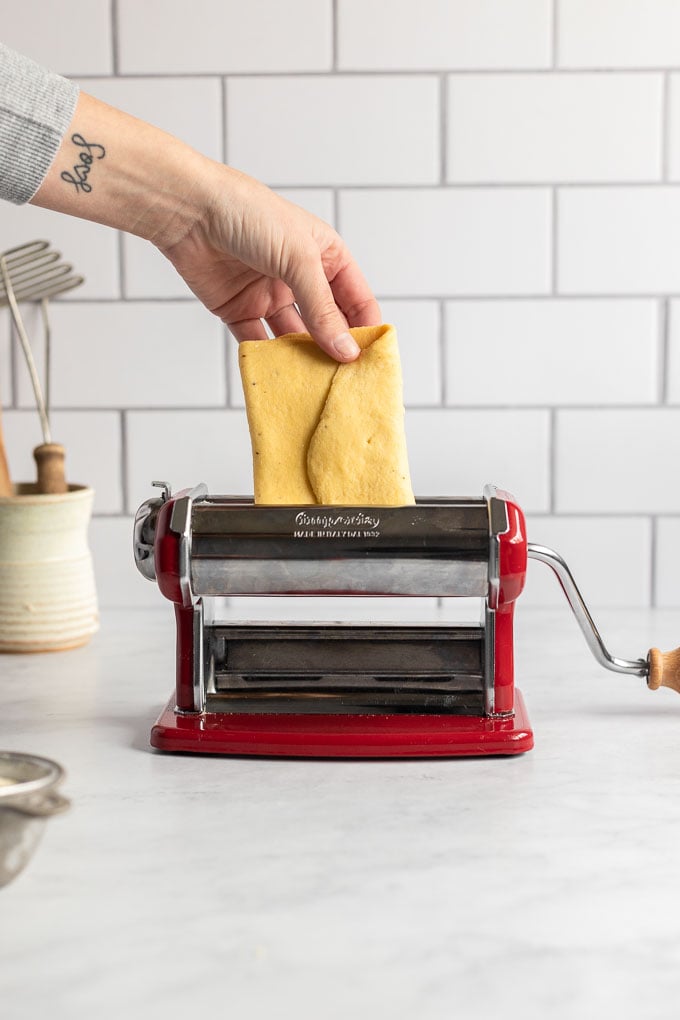
Once you’ve gone through the largest setting a couple of times and have a solid ‘rectangle type base’, thread the dough through each smaller setting, one by one until you’ve reached the desired thickness.
I like to end with the second-to-last thinnest setting, however, if you’re really brave, you can go as thin as possible. Keep in mind if you do use the thinnest setting, the sheet will be more delicate to work with.
Stopping at the second to last smallest setting makes it a little easier to work with less risk of tearing. I also find the slightly thicker ravioli gives me more pasta bite, which I love. Again, use your preference!
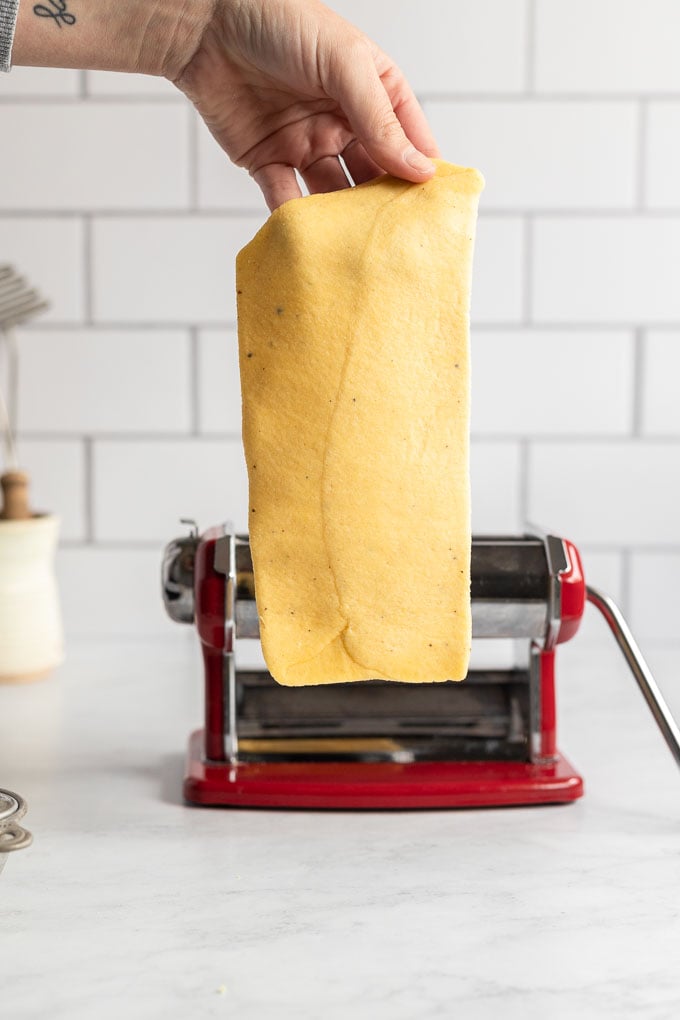
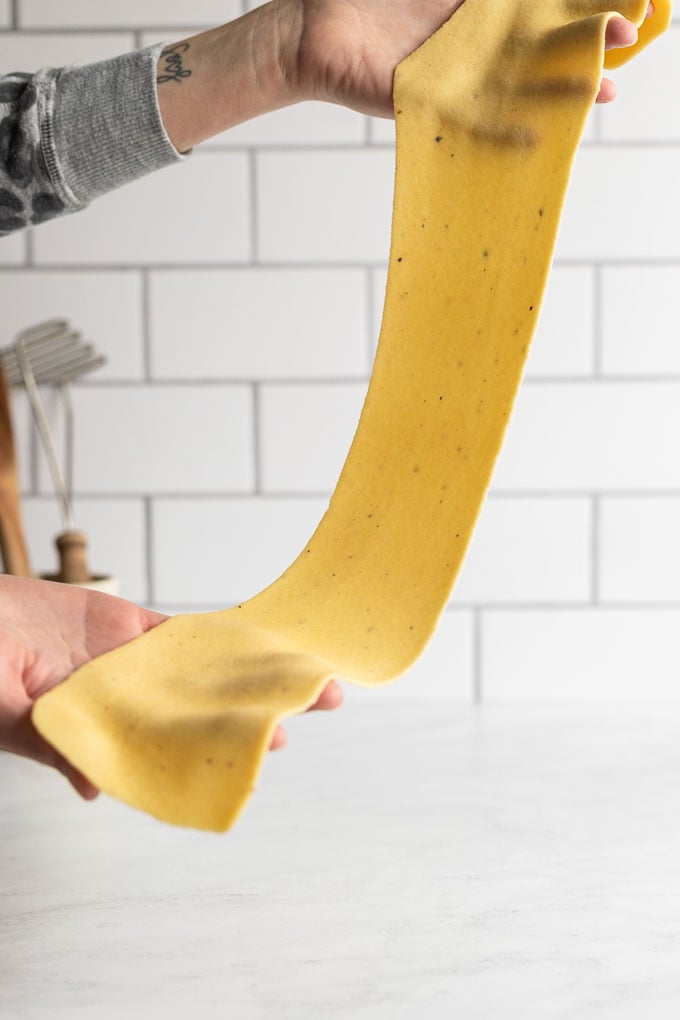
Now it’s time to fill the ravioli!
Step two: Once the dough is fully rolled out in a long rectangle, place dollops of the filling spaced about 1 to 1 1/2 inches apart on one half of the dough.
You want to place it on one side because we will be folding it up to create the ravioli pockets. I like using a small cookie scoop to place the filling so I have an equal amount for each pocket.
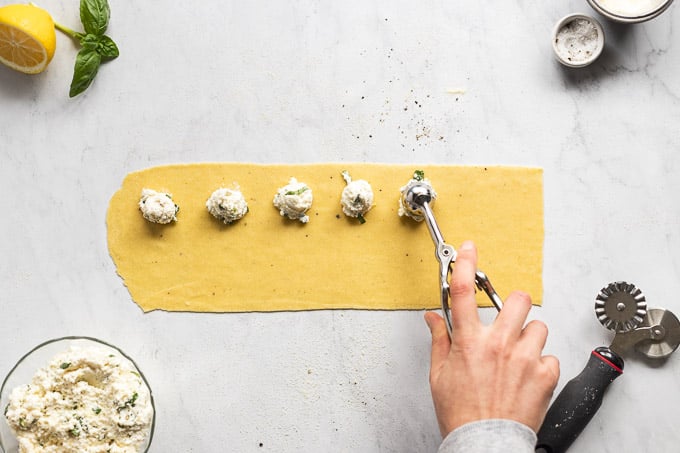
Step three: once you have the filling spaced on the entire length of your pasta sheet, fold the other half of the dough on top of the filling.
It helps to dip your finger in water and run it around the pasta edges before folding. This can help the dough stick to itself if it seems a little dry.
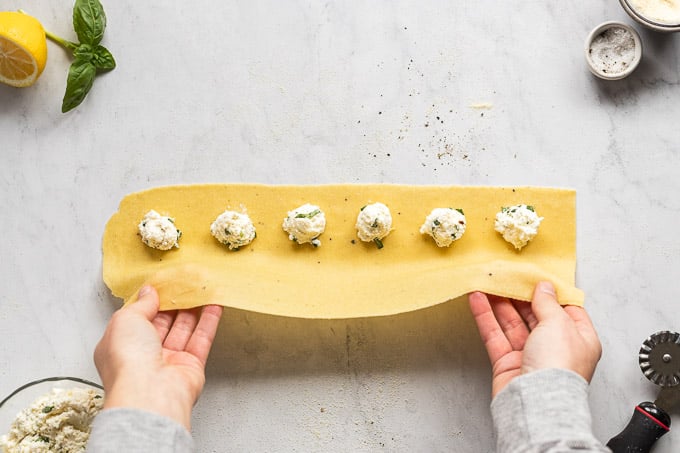
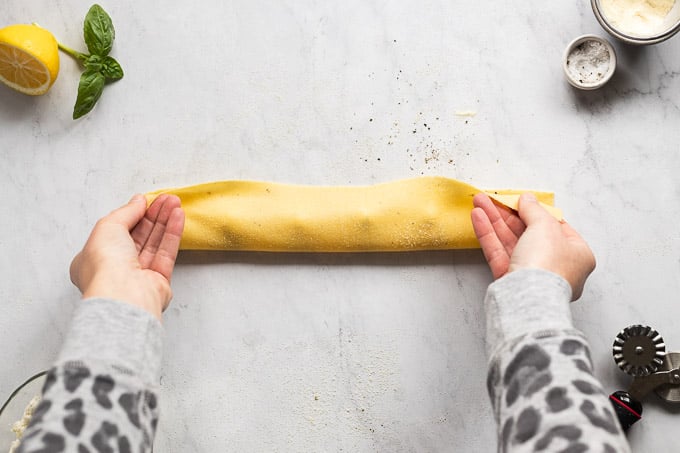
Step four: gently press around each filling to create the beginning of each pocket.
As you press the pasta around the filling, the edges will stick together. You want to be gentle, yet firm, to ensure that it begins to stick together.
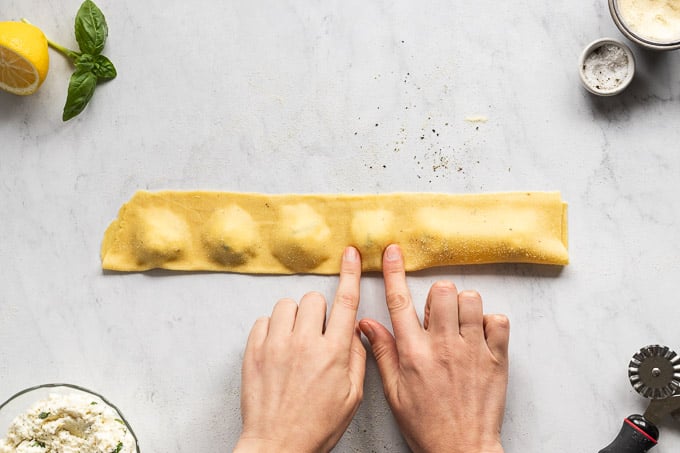
Step five: now that you’ve pressed the dough down and you can see where each pocket will be, use a pizza cutter or pasta wheel to cut between each pocket.
Once the pockets are cut apart, again press the edges down as needed, or use a fork to make sure they are fully pressed together if you’re concerned they won’t stick together.
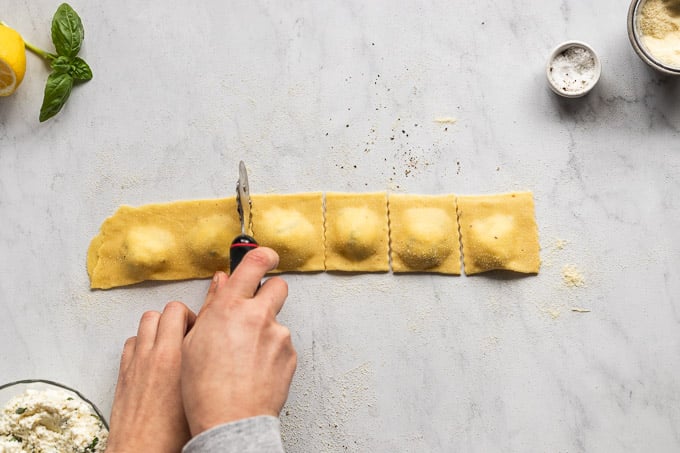
Now that you have each pocket formed, gently lift them from your counter and place them on a semolina flour-lined plate or baking sheet until ready to cook. Continue the steps with the remaining sheets of pasta dough before you get to cooking!
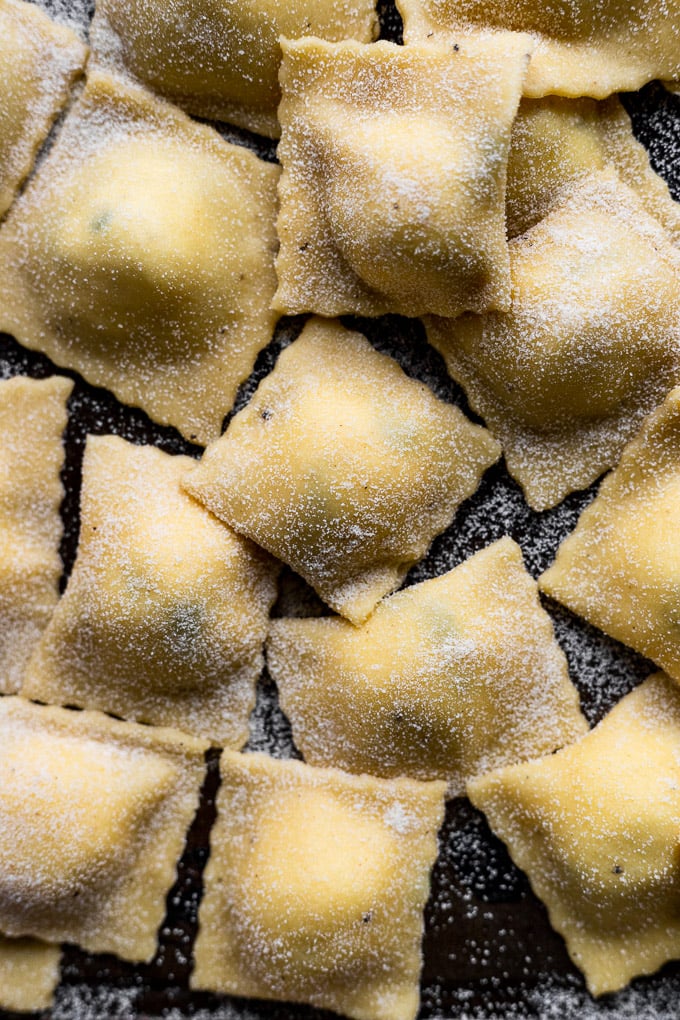
At this point, I would recommend starting a pot of salted water as you prepare the ravioli pockets so it can come to a boil and be ready to cook them when you are finished forming the pockets.
How to Cook Ravioli
Once the large stockpot of salted water has come to a boil, gently add the ravioli to the pot in batches. Be careful not to overcrowd the pan. Ravioli should have room to swim around a little bit.
Depending on the size of the ravioli, they’ll cook for 2-4 minutes. The ravioli will float when they’re ready to be removed, and you can always taste test to get the perfect timing for al dente ravioli. Remember, the ravioli will finish cooking in their sauce and no one wants soggy ravioli.
Once they’re ready, remove the pockets using a spider-like strainer with a handle to easily remove them without the risk of burning yourself. If needed, a slotted spoon will do, too.
Then transfer the ravioli pockets directly into your sauce. It’s ok if a little water transfers over, too, because pasta water helps the sauce adhere to the pasta!
After the ravioli has finished in the sauce, serve immediately with parmesan cheese, red pepper flakes, and basil as garnishes.
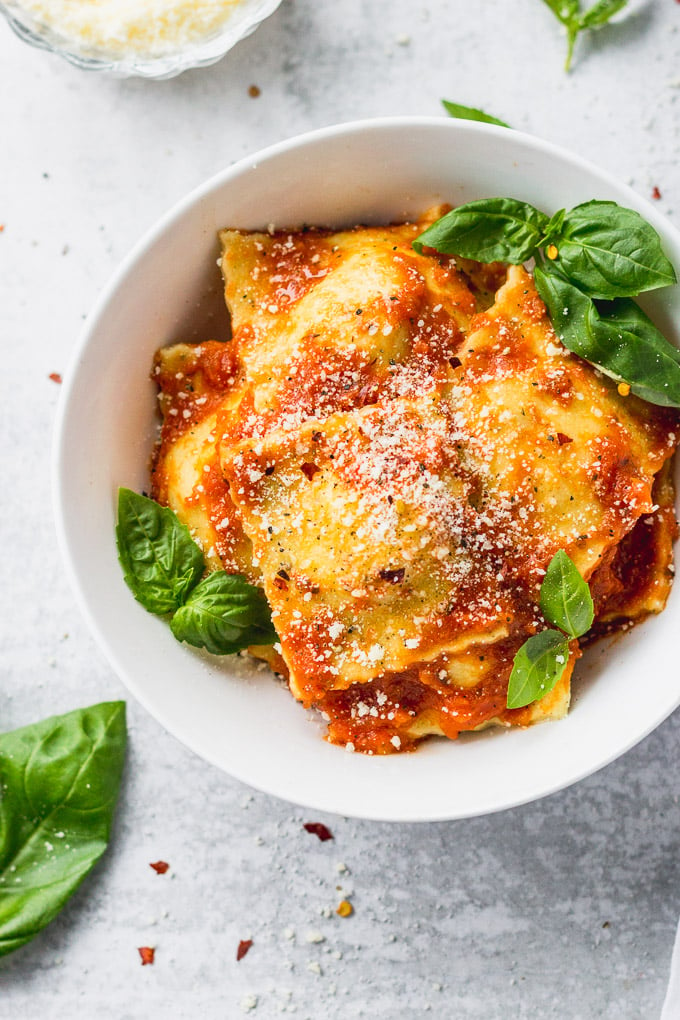
How to Serve Homemade Cheese Ravioli
- With your favorite sauce. I recommend a marinara sauce for these beauties. It’s the traditional route and is darn delicious. A nice roasted tomato sauce is always so, so good, too!
- With lots of parmesan cheese on top!
- Extra basil!
Then get ready for the cheesy goodness with a mix of subtle flavors to burst out with every bite.
Of course, to make it a balanced meal, you can serve it with a side salad (oh, Caesar, how you have my heart). Roasted broccolini is great, too (my go-to if you haven’t noticed). Really make it Italian night with our 5-star vegetarian meatballs, too!
But let me be clear: you can absolutely eat this as a meal in itself and you would not be the first.
There you have it! Whether it’s date night at home or you need a little self-care in the form of homemade ravioli, this recipe is the one!
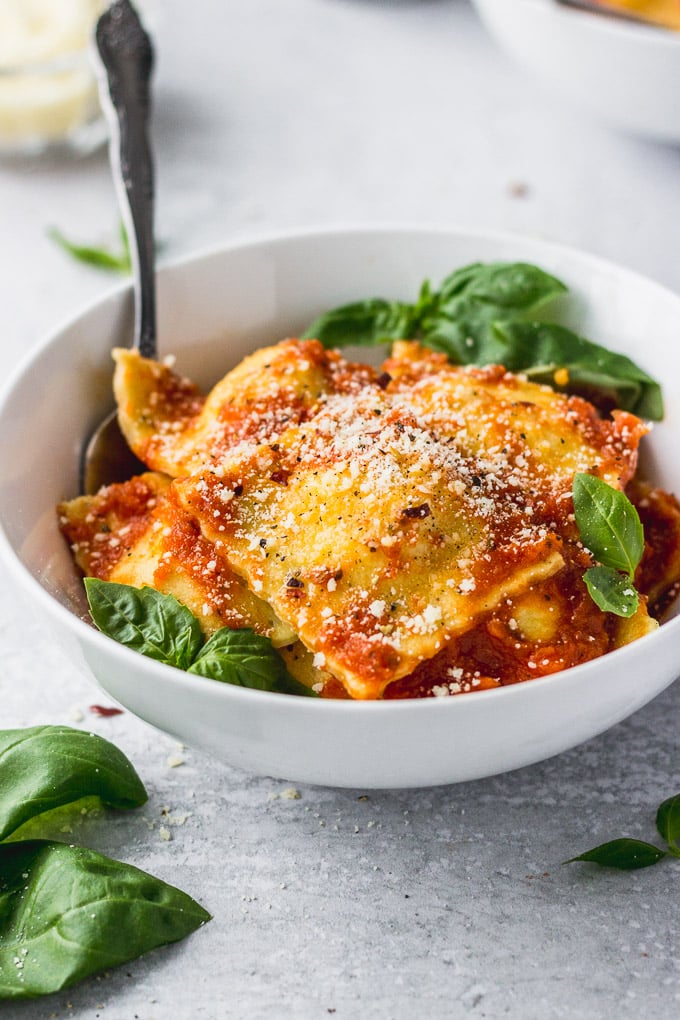
Storage and Freezer Tips
Homemade ravioli is best if prepared the day it’s made, however, I totally get wanting to have a stash waiting for you when the craving for homemade pasta strikes. When that happens, there’s no going back.
If you are making the ravioli the same day you prepared them, store them in the fridge on the flour-coated baking sheet until ready to boil.
To freeze the ravioli pockets, place the sheet pan in the freezer for several hours until the pockets are frozen, then, transfer them to a freezer-safe bag (I love my Stasher bags!). Store them in the freezer for up to two months. When you’re ready to use them, simply boil them from frozen until they’re floating and serve as you would with sauce.
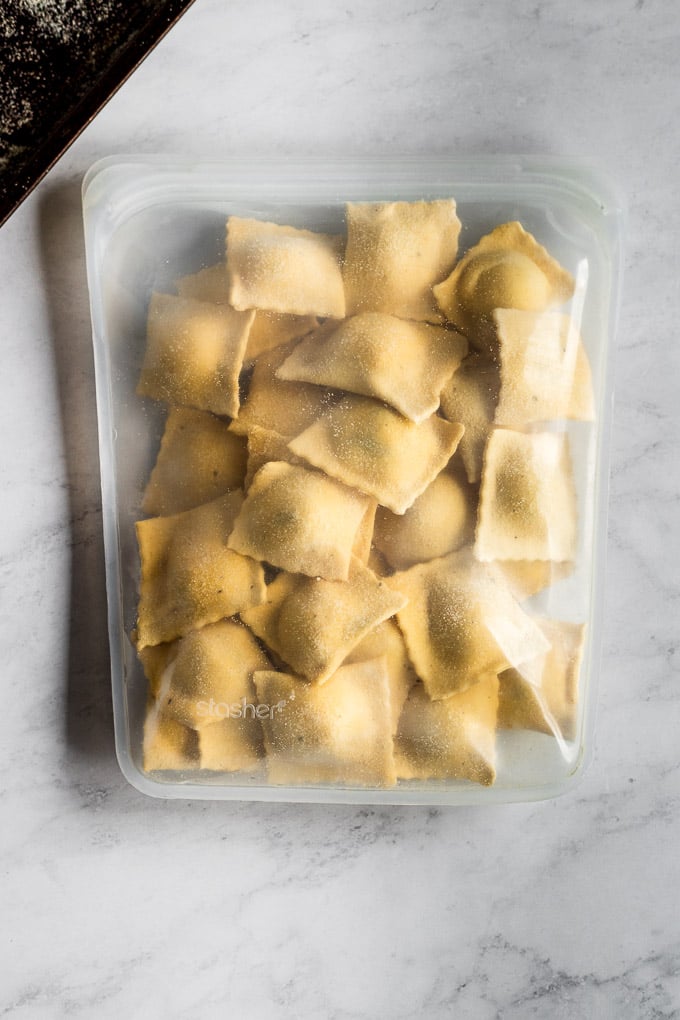
More Vegetarian Ravioli Recipes:
Did you make this recipe? Please leave a star rating and review in the form below. I appreciate your feedback, and it helps others, too!
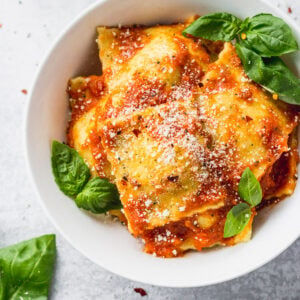
Get the Recipe Homemade Cheese Ravioli with Ricotta
Ingredients
- 1 pound Fresh Pasta Dough*, or store-bought fresh pasta sheets
- 1 cup whole milk ricotta
- 1/3 cup parmesan cheese*, freshly shredded
- ⅛-¼ teaspoon lemon zest , see notes
- 2 teaspoons fresh basil , finely chopped or 1 tsp dried
- 1/16 teaspoon ground nutmeg
- Salt and pepper to taste
- Homemade Tomato Sauce, or sauce as desired, for serving
- Parmesan and/or basil , for garnish
Equipment
- #60 Cookie Scoop or smaller
Instructions
- Make the fresh pasta dough and let it rest as directed. Spread additional semolina flour on a baking sheet and set aside to hold the finished ravioli pockets.
- Make the filling: In a bowl, combine the ricotta, parmesan cheese, lemon zest, basil, nutmeg, salt, pepper. Taste test to adjust any levels according to your taste. Set aside or in the fridge if not using right away.1 cup whole milk ricotta, 1/3 cup parmesan cheese*, ⅛-¼ teaspoon lemon zest, 2 teaspoons fresh basil, 1/16 teaspoon ground nutmeg, Salt and pepper to taste
- Bring a large pot of salted water to a boil, because this will take a while, I like to start it before or while forming the pasta so it’s ready once the ravioli is formed.
- Rolling out the dough: Take approximately 1/4 of the fresh dough ball (either cut it into sections or tear off a portion). Using your hands form it into a rectangle shape, just thick enough that it will fit into the largest setting on your pasta machine (use a pasta machine for best results, but a rolling pin will work, too). Roll it out on the largest setting, adjusting and folding into a rectangular shape again as needed. Each time you roll it out, it will expand how it was placed in, so making it a uniform rectangle as much as possible will help you later on.1 pound Fresh Pasta Dough*
- Once you’ve gone through the largest setting and have a solid ‘rectangle type base’, thread the dough through each smaller setting, one by one until you’ve reached your desired thickness. I like to go with the second to last thinnest setting, however, if you’re really brave you can go as thin as possible. Place the rolled out sheet on the countertop dusted with semolina flour to prevent sticking.
- On one half of the rolled-out dough section, place approximately 1 to 1.5 tsp dollops of the filling spaced about 1 1/2 inches apart. You want to place it on one half because we will be folding the dough up to create the ravioli pockets. I find that a small cookie scoop to place the filling gives the perfect equal amount for each pocket.
- With the filling spaced on the entire length of your pasta sheet, fold over the other half of the dough on top of the filling. You may want to use your finger dipped in water and run it around the pasta edges before folding, to help the dough stick, if it seems a little dry.
- Gently press around each filling to create the beginning of each pocket. Use a pizza cutter or pasta wheel to cut between each pocket. Press the edges down as needed, or use a fork to make sure they are fully pressed together). Place the pockets on your prepared baking sheet and continue forming ravioli with the remaining pasta sheets.
- Once the water is at a rolling boil, add the ravioli pockets in batches. Be sure to not overcrowd the pan. The ravioli pockets will take approximately 2-4 minutes to cook to al dente, depending on the size of the ravioli. You’ll know they’re ready when they float. That being said, if you’re going to finish them in the sauce for longer than a minute or so, you may want to remove them slightly early and let them finish completely in the sauce. Either way, remove them from the pasta water and place them directly into your sauce. Continue to cook all ravioli.
- Serve immediately and garnish with additional parmesan cheese and basil as desired. Enjoy your creation!
Notes
- This recipe makes approximately 48, 1 1/2 inch ravioli pieces.
- Ricotta: if your ricotta has any excess liquid, drain it off or make sure it’s thoroughly mixed in so that it doesn’t make the filling too watery.
- To freeze ravioli: lay out on a parchment paper-lined baking sheet. Place in the freezer until completely frozen, then transfer the ravioli to a freezer bag. When ready to use, boil as directed above for about 2-3 minutes longer.
- 10/2020 Update: Suggested a range for the lemon zest per reader feedback; add 1/8 tsp and taste test, adding more as desired. It adds a nice brightness to the pasta, but you can omit it if you so choose.
- *use specifically vegetarian parmesan cheese if needed
This recipe is part of our Date Night Recipes to Love roundup. Check it out!

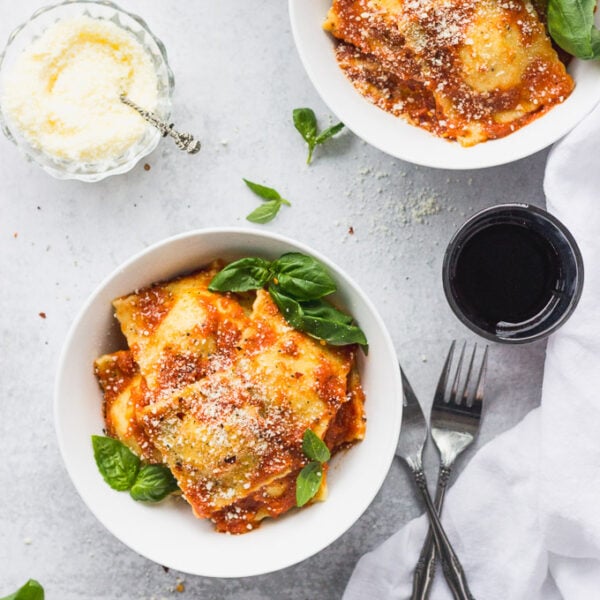








I just made this recipe last night as well as your pasta dough and it was fantastic! Definitely making it again!
That’s so awesome to hear, Rachael! Glad you enjoyed it!
Just made this tonight. My son is a tough critic. He loved it had some pasta flour so kind of followed the dough recipe. Found it took longer to cook the tomato sauce recipe but that doesn’t matter the sauce is so lovely it will become a household favourite and you are right there is nothing finer than a homecooked tomato pasta sauce….amazing. Need to practice making ravioli but not bad for a first attempt.
Thankyou 🥰
I’m so glad to hear! Thanks for commenting!
I doubled the pasta and the filling. I rolled it out very thin (about a 5 on my kitchen aid roller). It made 25 ravioli before running out of filling. Only needed a quarter of the dough. I have to say, in not a fan of the lemon zest. I wish the cheese mixture was a little more firm as well. I refrigerated it while the dough 2 resting.
Thanks for the feedback, Liz! I’d recommend adding in some mozzarella if you make it again, that will add some ‘firmness’ to the filling.
i made this and pasta was great but the cheese turned almost melted. I tried putting more in, cooking longer or shorter, but really unhappy with it
Hi Catherine – sorry to hear the filling wasn’t what you expected. Since it is a ricotta filling, it is softer. If you’d like it firmer, I’d recommend adding mozzarella cheese to the filling next time.
My new go-to ravioli filling. My husband loved it, too!
So glad to hear! Thanks, Emily!
Loved it. Ate my for 2 days
I’m so glad to hear you loved it! Thanks, James!
First time ever making homemade pasta and I made the raviolis a little too big but it still.turned out good. I use a marinara sauce i had in my pantry. The pasta .turned out great! I’ll be making this again but next time.try to make my raviolis smaller and use a better marinara sauce.
Awesome, I’m so glad to hear! Thank you for making them and taking the time to leave your review, Valerie!
Absolutely delighted with the homemade cheese ravioli recipe! 🌟 The pasta dough was easy to work with, creating thin, delicate sheets that perfectly encased the rich and flavorful cheese filling.
Awesome, so glad to hear!
A perfect recipe! Delicious through and through. The lemon zest is the ultimate touch of attention to detail to me! Delicious.
Thanks, Matt! I’m so glad you enjoyed it!